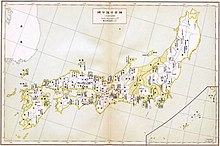Shugo (守護), commonly translated as “(military) governor,” “protector,” or “constable,” was a title given to certain officials in feudal Japan. They were each appointed by the shogun to oversee one or more of the provinces of Japan. The position gave way to the emergence of the daimyo (military feudal lords) in the late 15th century, as shugo began to claim power over lands themselves, rather than serving simply as governors on behalf of the shogunate.

The post is said to have been created in 1185 by shogun Minamoto no Yoritomo to aid the capture of Yoshitsune, with the additional motivation of extending the rule of the Minamoto shogunate government throughout Japan. The shugo (military governors) progressively supplanted the existing kokushi (civil governors), who were appointed by the Imperial Court in Kyoto. Officially, the gokenin in each province were supposed to serve the shugo, but in practice, the relationship between them was fragile, as the gokenin were vassals of the shōgun as well.
Shugo often stayed for long periods in the capital, far from their province, and were sometimes appointed shugo for several provinces at the same time. In such cases, a deputy shugo, or shugodai (守護代), was appointed.
Over time, the powers of some shugo grew considerably. Around the time of the Ōnin War (1467–1477), conflicts between shugo became common.[1] Some shugo lost their powers to subordinates such as the shugodai, while others strengthened their grip on their territories. As a result, at the end of the 15th century, the beginning of the Sengoku period, the power in the country was divided amongst military lords of various kinds (shugo, shugodai, and others), who came to be called daimyōs.
Below is a list of some of the major clans that produced shugos and daimyōs during the Muromachi era and Sengoku period, as well as the regions over which they ruled.